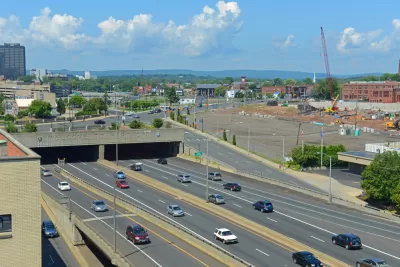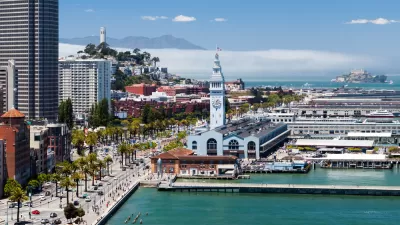A new plan would spend an estimated $17 billion to remove a huge chunk of the Interstate Highway System's footprint in Hartford, Connecticut.

Tom Condon reports on an ambitious new plan to recover some of what was lost when interstate freeways were built through the city six decades ago.
First, the historical context:
Decades ago, the construction of I-91 cut Hartford off from the Connecticut River. I-84 isolated the North End from downtown and consumed a large swath of land and many historic buildings, including the majestic Hartford Public High School campus. The interchange of the two highways laid waste to part of the central business district.
East Hartford wasn’t spared; its massive “mixmaster” interchange occupies an area the size of downtown Hartford.
Two plans have attempted to rectify the damage from these decisions in the past decade, according to Condon, but neither made much progress. But a new plan, emerging as a hybrid of the previous ideas, has emerged.
"The new plan is part of a regional planning effort called Hartford 400, initiated by the iQuilt project in Hartford. It envisions a roughly triangular ring road around the downtown, with some tunneling but much less than Larson proposed, and new connections to East Hartford," according to Condon. The project would cost an estimated $17 billion, but the results would include removing the I-84/I-91 and "mixmaster" interchanges, freeing up more than 150 acres of "prime urban land" for development. In addition, the plan would also cap I-91 through downtown Hartford.
The article includes more details about the iQuilt Partnership, the brainchild of Hartford native and Los Angeles-based urban planner, Doug Suisman.
FULL STORY: There’s a new plan for realigning Hartford’s highways. Is the third time the charm?

Alabama: Trump Terminates Settlements for Black Communities Harmed By Raw Sewage
Trump deemed the landmark civil rights agreement “illegal DEI and environmental justice policy.”

Study: Maui’s Plan to Convert Vacation Rentals to Long-Term Housing Could Cause Nearly $1 Billion Economic Loss
The plan would reduce visitor accommodation by 25% resulting in 1,900 jobs lost.

Why Should We Subsidize Public Transportation?
Many public transit agencies face financial stress due to rising costs, declining fare revenue, and declining subsidies. Transit advocates must provide a strong business case for increasing public transit funding.

Paris Bike Boom Leads to Steep Drop in Air Pollution
The French city’s air quality has improved dramatically in the past 20 years, coinciding with a growth in cycling.

Why Housing Costs More to Build in California Than in Texas
Hard costs like labor and materials combined with ‘soft’ costs such as permitting make building in the San Francisco Bay Area almost three times as costly as in Texas cities.

San Diego County Sees a Rise in Urban Coyotes
San Diego County experiences a rise in urban coyotes, as sightings become prevalent throughout its urban neighbourhoods and surrounding areas.
Urban Design for Planners 1: Software Tools
This six-course series explores essential urban design concepts using open source software and equips planners with the tools they need to participate fully in the urban design process.
Planning for Universal Design
Learn the tools for implementing Universal Design in planning regulations.
Smith Gee Studio
Alamo Area Metropolitan Planning Organization
City of Santa Clarita
Institute for Housing and Urban Development Studies (IHS)
City of Grandview
Harvard GSD Executive Education
Toledo-Lucas County Plan Commissions
Salt Lake City
NYU Wagner Graduate School of Public Service





























